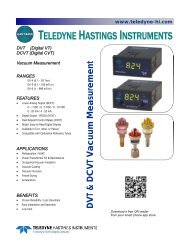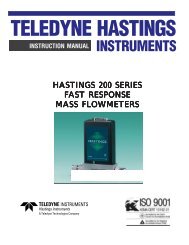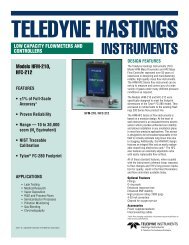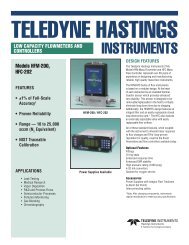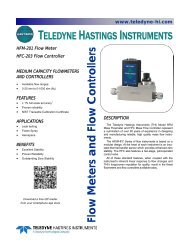HFM-301/305 HFC-303/307 - Teledyne Hastings Instruments
HFM-301/305 HFC-303/307 - Teledyne Hastings Instruments
HFM-301/305 HFC-303/307 - Teledyne Hastings Instruments
- No tags were found...
You also want an ePaper? Increase the reach of your titles
YUMPU automatically turns print PDFs into web optimized ePapers that Google loves.
7. Appendix<br />
7.1. Appendix 1- Volumetric versus Mass Flow<br />
Mass flow measures just what it says, the mass or number of molecules of the gas flowing through the<br />
instrument. Mass flow (or weight per unit time) units are given in pounds per hour (lb/hour), kilograms<br />
per sec (kg/sec) etc. When your specifications state units of flow to be in mass units, there is no reason<br />
to reference a temperature or pressure. Mass does not change based on temperature or pressure.<br />
However, if you need to see your results of gas flow in volumetric units, like liters per minute, cubic feet<br />
per hour, etc. you must consider the fact that volume DOES change with temperature and pressure. To<br />
do this, the density (grams/liter) of the gas must be known and this value changes with temperature and<br />
pressure.<br />
When you heat a gas, the molecules have more energy and they move around faster, so when they<br />
bounce off each other, they become more spread out, therefore the volume is different for the same<br />
number of molecules.<br />
Think about this:<br />
The density of Air at 0°C is 1.29 g/liter<br />
The density of Air at 25°C is 1.19 g/liter<br />
The difference is 0.1 g/liter. If you are measuring flows of 100 liters per minute, and you don’t use the<br />
correct density factor then you will have an error of 10 g/minute!<br />
Volume also changes with pressure. Think about a helium balloon with a volume of 1 liter. If you could<br />
scuba dive with this balloon and the pressure on it increases. What do you think happens to the weight<br />
of the helium It stays the same. What would happen to the volume (1 liter) It would shrink.<br />
Why is the word standard included with the volume terms liters and cubic feet in mass flow applications<br />
A mass flow meter measures mass …and we know we can convert to volume.<br />
To use density we must pick one (or standard) temperature and pressure to use in our calculation.<br />
When this calculation is done, the units are called standard liters per minute (SLM) or standard cubic<br />
feet per minute (SCFM), for instance, because they are referenced to a standard temperature and<br />
pressure when the volume is calculated.<br />
Using the example to the left, we can see a<br />
standard liter can be defined differently. The first<br />
balloon contains 0.179 grams of Helium at 0 °C<br />
and 760 Torr (density of 0.179 grams/liter). Heat<br />
up that balloon to room temperature and the<br />
volume increases, but the mass has not changed.<br />
The volume is not 1 liter anymore, it is 1.08<br />
liters.<br />
So, to define a standard liter of Helium at 25 °C,<br />
we must extract only one liter from the second<br />
balloon and that liter weighs only 0.175 grams.<br />
1 Liter 1.08 Liter 1 Liter<br />
0 °C<br />
0.179 grams/1<br />
liter<br />
25 °C<br />
0.179 g/1.08<br />
liters<br />
25 °C<br />
0.164 grams<br />
If a mass flow meter is set up for STP at 0 °C and<br />
760 Torr, when it measures 0.179 grams of He, it<br />
will give you results of 1 SLM. If a second meter<br />
is set up for STP at 25 °C and 760 Torr, when it<br />
measures 0.164 grams, it will give results of 1<br />
SLM.<br />
Manual: 152-082010 <strong>301</strong>-<strong>305</strong>-306_<strong>303</strong>-<strong>307</strong> Series Page 33 of 35




